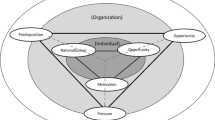Abstract
Violent groups sometimes invest significant resources in social work, notably in the form of charities and NGOs. The present paper models a terrorist group's charities as a means to advertise its cause in order to raise popular support. The analysis explains how different types of organizations arise in equilibrium, depending on government policies. Then, the interaction between a purely terrorist group and an independent local NGO is examined. It is shown that a purely terrorist group always invests in more attacks than an integrated terrorist-charity organization. Furthermore, the latter may have more NGO activity than a separate local NGO.
Similar content being viewed by others
References
Azam, J.-P. (2006). On thugs and heroes: Why warlords victimize their own civilians? Economics and Governance, 7(1), 53–73.
Azam, J.-P. (2005a). Suicide bombing as inter-generational investment. Public Choice, 122(1), 177–198.
Azam, J.-P. (2005b). How to curb “high quality” terrorism? A case for boosting aid, working paper, University of Toulouse, mimeo.
Azam, J.-P., & Mesnard, A. (2002). Civil war and the social contract. Public Choice, 105(3), 455–475.
Barro, R. (1990). Government spending in a simple model of endogenous growth. Journal of Political Economy, 98(5), S103–S126.
Becker, G.S., & Murphy, K.M. (1993). A simple model of advertising. Quaterly Journal of Economics, 108(4), 941–964.
Berman, E. (2003). “Hamas, Taliban and the Jewish underground: An economist's view of radical religious militias”, NBER WP 10004.
Berman, E., & Laitin, D.D. (2005). Hard targets: Theory and evidence on suicide attacks. NBER WP 11740.
Besley, T., & Gathak, M. (2001). Government versus private ownership of public goods. The Quarterly Journal of Economics, 116(4), 1343–1372.
Bueno de Mesquita, E. (2005). The quality of terror. American Journal of Political Science, 49(3), 515–530.
Bueno de Mesquita, E., & Dickinson, E.S. (2005). The propaganda of the deed: Terrorism, counterterrorism, and mobilization, working paper, Department of Political Science, Washington University.
Faria, J.R., & Ace, M.D.G. (2005). Terror support and recruitment. American Economic Association Annual Meeting Papers, available at http://www.aeaweb.org/annual_mtg_papers/2005papers.html
Fawwaz, M. (2004). Action et Idéologie dans les Services: ONG Islamiques dans la Banlieue Sud de Beyrouth. In: S. Ben Néfissa, N. Abd al-Fattah, S. Hanafi & M. Carlos (Eds.), ONG et Gouvernance dans le Monde Arabe, Cedej (Le Caire) et Karthala (Paris).
Ferrero, M. (2004). Revolution or reform? Socialism's dilemma as a rational choice problem. Homo Oeconomicus, 21(2), 251–282.
Ghandour, A.R. (2002). Jihad Humanitaire: Enquête sur les ONG Islamiques. Flammarion (Paris).
Glazer, A., & Konrad, K.A. (1996). A signaling explanation for charity. American Economic Review, 86(4), 1019–1028.
Guevara, E.C. (2001). Textes Militaires. La découverte (Paris).
Hopkins, R., & Scott, C.D. (1999). The economics of non-governmental organizations. The Development Economics Discussion Paper Series, The Suntory Center, London School of Economics.
Jack, W. (2001). Public policy towards non-governmental organizations in developing countries, working paper, Department of Economics, Georgetown University.
Krueger, A.B., & Maleckova, J. (2003). Education, poverty, political violence, and terrorism: Is there a causal connection? Journal of Economic Perspectives, 17(4), 119–144.
Levitt, M.A. (2003). Hamas Blood Money: Mixing Good Works and Terror is No Formula for Peace, Available at http://www.ict.org.il
Levitt, M.A. (2002). The Network of Terrorist Financing, available at http://www.ict.org.il
Rose-Ackerman, S. (1998). Altruism, nonprofits, and economic theory. Journal of Economic Literature, 34, 701–728.



